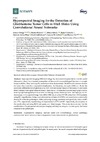Identificador persistente para citar o vincular este elemento:
https://accedacris.ulpgc.es/jspui/handle/10553/73844
| Título: | Hyperspectral imaging for the detection of glioblastoma tumor cells in H&E slides using convolutional neural networks | Autores/as: | Ortega Sarmiento, Samuel Halicek, Martin Fabelo Gómez, Himar Antonio Camacho, Rafael Plaza De La Luz, María Godtliebsen, Fred Marrero Callicó, Gustavo Iván Fei, Baowei |
Clasificación UNESCO: | 3314 Tecnología médica | Palabras clave: | Hyperspectral imaging optical pathology convolutional neural networks medical optics and biotechnology |
Fecha de publicación: | 2020 | Publicación seriada: | Sensors | Resumen: | Hyperspectral imaging (HSI) technology has demonstrated potential to provide useful information about the chemical composition of tissue and its morphological features in a single image modality. Deep learning (DL) techniques have demonstrated the ability of automatic feature extraction from data for a successful classification. In this study, we exploit HSI and DL for the automatic differentiation of glioblastoma (GB) and non-tumor tissue on hematoxylin and eosin (H&E) stained histological slides of human brain tissue. GB detection is a challenging application, showing high heterogeneity in the cellular morphology across different patients. We employed an HIS microscope, with a spectral range from 400 to 1000 nm, to collect 517 HS cubes from 13 GB patients using 20 ✕ magnification. Using a convolutional neural network (CNN), we were able to automatically detect GB within the pathological slides, achieving average sensitivity and specificity values of 88% and 77%, respectively, representing an improvement of 7% and 8% respectively, as compared to the results obtained using RGB (red, green, and blue) images. This study demonstrates that the combination of hyperspectral microscopic imaging and deep learning is a promising tool for future computational pathologies. | URI: | https://accedacris.ulpgc.es/handle/10553/73844 | ISSN: | 1424-8220 | DOI: | 10.3390/s20071911 | Fuente: | Sensors [ISSN 1424-8220], v. 20 (7), 1911 |
| Colección: | Artículos |
Citas SCOPUSTM
80
actualizado el 08-jun-2025
Citas de WEB OF SCIENCETM
Citations
67
actualizado el 08-jun-2025
Visitas
110
actualizado el 15-mar-2025
Descargas
186
actualizado el 15-mar-2025
Google ScholarTM
Verifica
Altmetric
Comparte
Exporta metadatos
Los elementos en ULPGC accedaCRIS están protegidos por derechos de autor con todos los derechos reservados, a menos que se indique lo contrario.
